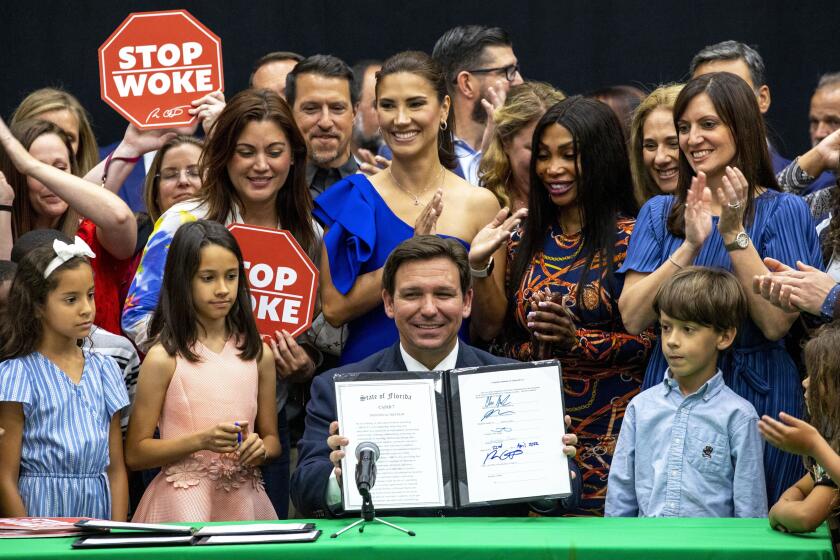Dr. Edward Brandt Jr., 74; official oversaw first federal response to AIDS
Dr. Edward N. Brandt Jr., the Oklahoma physician who oversaw the federal government’s first response to the AIDS epidemic and who initiated requirements for tamper-proof drug packaging after a highly publicized Tylenol poisoning incident, died Aug. 26 at his home in Oklahoma City.
He was 74 and had been suffering from lung cancer. It was on Brandt’s watch as the government’s top physician that the United States issued its strongest reports that linked smoking to cancers of the lung and other organs. He was not a smoker, however.
Brandt was in Washington in March 1981 for confirmation hearings on his appointment as assistant secretary of the Department of Health and Human Services when a researcher from the Centers for Disease Control and Prevention told him about the mysterious symptoms of three young, gay men from Los Angeles.
By midsummer, several other cases had been reported and it was clear that all the men’s immune systems had been severely suppressed, leading to the disease’s formal name, acquired immune deficiency syndrome.
Up to that period, Brandt said later, responses to disease outbreaks had been carried out by cities, states and private organizations.
The March of Dimes, for example, led the fight against polio and the development of two vaccines with little government funding.
Brandt, however, thought that the federal government should be more directly involved and that AIDS was a good test case.
He established a government hotline to provide information about the outbreak and appointed three prominent researchers -- Dr. James Curran of the disease control center and Dr. Anthony Fauci and Dr. Robert Gallo of the National Institutes of Health -- to head teams searching for what caused AIDS, how it spread and how it might be treated.
AIDS “was the first time in our nation’s history that the federal government was called upon to fight an epidemic,” Brandt said later. “That represented a historic change.”
It was not an easy battle. President Reagan was attempting to cut funding for federal health research, including eliminating more than 700 positions at the disease control center.
Brandt resisted the cuts behind the scenes and quietly fought to ensure adequate money was funneled into the anti-AIDS effort.
He also played a major role in obtaining funding for the disease control center to build a maximum-security laboratory for research into highly pathogenic disease organisms, an effort that had been blocked by the Reagan administration.
He made a serious misstep, however, in 1984, when he and Health and Human Services Secretary Margaret M. Heckler announced that Gallo had identified the human immunodeficiency virus, or HIV, which causes AIDS -- leaving out the contributions of the French physician Dr. Luc Montagnier, who many consider to have played a bigger role in the discovery.
Heckler and Brandt said at the time that an HIV vaccine would be produced within three years and commercially available within five, a prediction that now seems wildly optimistic because an effective vaccine has still not been found.
Tamper-proof packaging arrived after an incident in late 1982 when seven Chicago residents died after consuming Tylenol capsules that had been filled with cyanide and placed back on store shelves. Police eventually traced the poisonings to con man James W. Lewis, who tried to extort large sums of money from Tylenol-maker McNeil Consumer Products. Lewis was convicted of extortion but not of murder.
As a result of the episode, Brandt encouraged drug makers to use tamper-proof packaging for their products. He sympathized with the public’s response to the difficult-to-open bottles.
“I have a hard time with those things too,” he said. “But the concept is so well accepted that people would be surprised now to get a product off the shelf that’s not tamper-proof.”
In addition to his roles in battling the AIDS epidemic and product tampering, Brandt took an active role in promoting research into women’s health and bringing more women into the federal scientific establishment, a role that led Dr. Vivian Pinn of the NIH’s Office of Research on Women’s Health to call him “the godfather of women’s health.”
Edward Newman Brandt Jr. was born in Oklahoma City on July 3, 1933.
He earned his undergraduate degree at the University of Oklahoma, a master’s degree at Oklahoma State University, and his M.D. degree and a doctorate in biostatistics at the University of Oklahoma.
Throughout his career, he held a variety of administrative positions, including vice chancellor for health affairs for the University of Texas system, chancellor of the University of Maryland at Baltimore and executive dean of the College of Medicine at the University of Oklahoma.
He continued teaching until he became too sick to continue.
Brandt is survived by his wife of 54 years, the former Patricia Lawson; three sons, Patrick J. and Edward III of Dallas and Rex C. of Clinton, Iowa; his father, Edward Sr. and stepmother Patricia; a sister, Jennifer Wessel of Dallas; a brother, Carlin, of Austin, Texas; and seven grandchildren.
More to Read
Start your day right
Sign up for Essential California for news, features and recommendations from the L.A. Times and beyond in your inbox six days a week.
You may occasionally receive promotional content from the Los Angeles Times.






